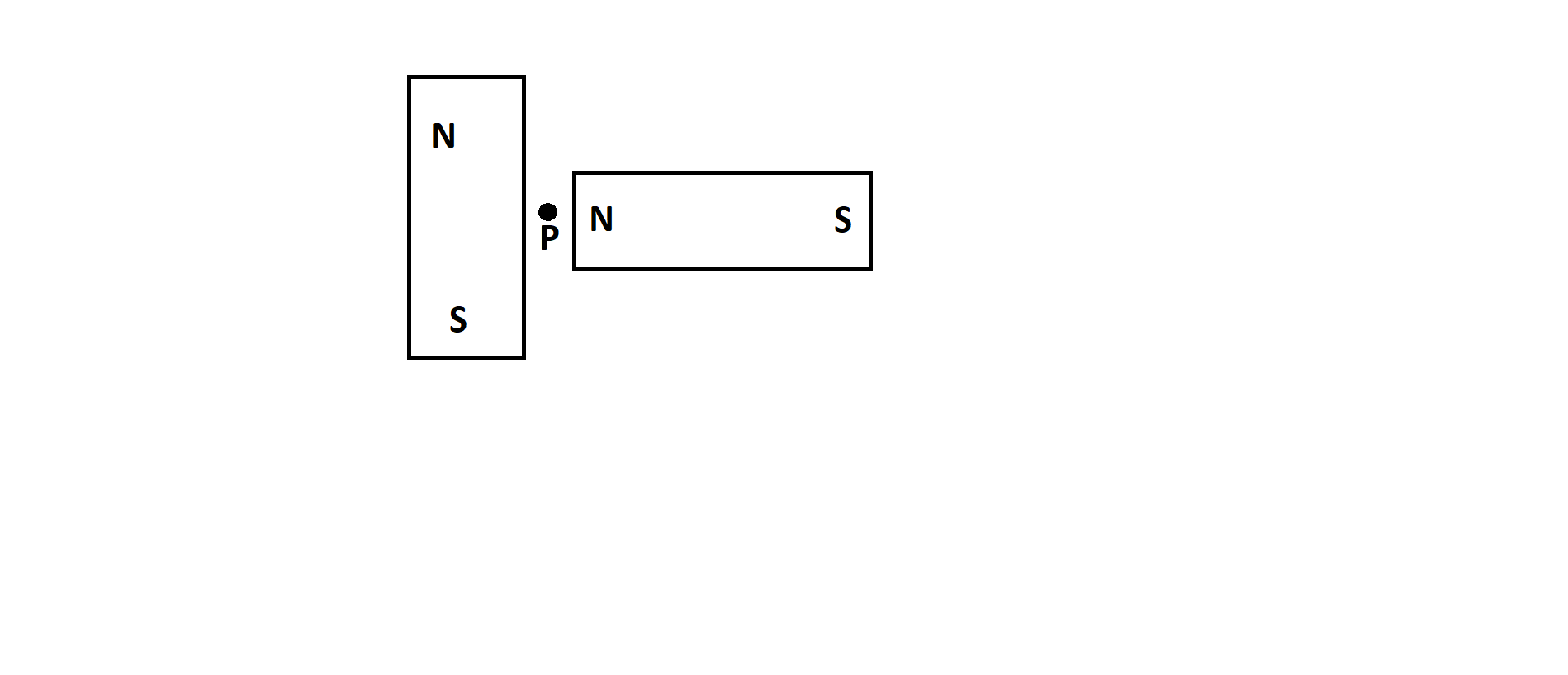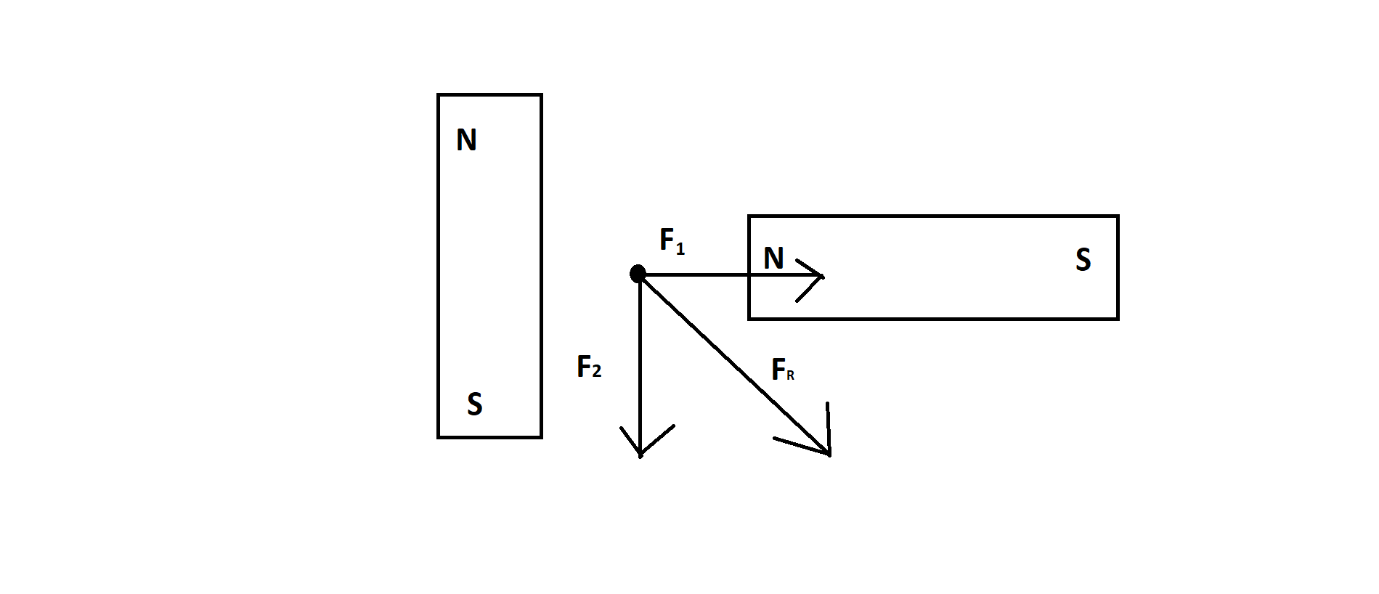
Two equal bar magnets are kept as shown in the figure. The direction of resultant magnetic field, indicated by arrow head at the point P is (approximately)

a) $ \to $
b) $ \nearrow $
c) $ \searrow $
d) $ \uparrow $
Answer
217.8k+ views
Hint:
Magnetic field is actually a vector quantity. For this reason we cannot just add them based on their magnitude to get the resultant magnetic field when they are perpendicular to each other. Therefore we can determine the direction of the net magnetic field of them by using resultant vector addition.
Complete step by step solution:
We know that vector quantities have both direction and magnitude. Same characteristics are found for magnetic fields, as they have both the direction as well as magnitude at a particular point. Magnetic field also follows the vector cross product rule. Hence the magnetic field is a vector quantity.
Even if there is another magnetic field present , the resultant of two magnetic fields would also follow the rules of vector addition.
Here in the given question, two equal bar magnets are placed perpendicular to each other. Hence, these two magnets produce magnetic fields around them. The direction of the resultant magnetic field can be determined by drawing a tangent to the magnetic lines of force.
Here the magnetic force of lines points to the region in which the magnetic force can be detected. Therefore the magnetic force of lines is nothing but a region of magnetic field.
So now we can draw magnetic field lines on that point for two magnets.

Now here we draw an image of the line of force at point P due to bar magnets. Here we see that the magnetic line of force ${F_1}$ is horizontal and ${F_2}$ is in vertical direction. Now if we find the resultant of these two vectors, we get ${F_R}$ . Now if we compare the option with them then we $ \searrow $ is the approximately matching with ${F_R}$ .
Therefore, the correct option is C.
Note:
The two magnetic field lines do not cross each other and there is a specific reason behind it. If two magnetic fields of lines would intersect then there would be two directions of the magnetic field at a certain point of time. This is just impossible.
Magnetic field is actually a vector quantity. For this reason we cannot just add them based on their magnitude to get the resultant magnetic field when they are perpendicular to each other. Therefore we can determine the direction of the net magnetic field of them by using resultant vector addition.
Complete step by step solution:
We know that vector quantities have both direction and magnitude. Same characteristics are found for magnetic fields, as they have both the direction as well as magnitude at a particular point. Magnetic field also follows the vector cross product rule. Hence the magnetic field is a vector quantity.
Even if there is another magnetic field present , the resultant of two magnetic fields would also follow the rules of vector addition.
Here in the given question, two equal bar magnets are placed perpendicular to each other. Hence, these two magnets produce magnetic fields around them. The direction of the resultant magnetic field can be determined by drawing a tangent to the magnetic lines of force.
Here the magnetic force of lines points to the region in which the magnetic force can be detected. Therefore the magnetic force of lines is nothing but a region of magnetic field.
So now we can draw magnetic field lines on that point for two magnets.

Now here we draw an image of the line of force at point P due to bar magnets. Here we see that the magnetic line of force ${F_1}$ is horizontal and ${F_2}$ is in vertical direction. Now if we find the resultant of these two vectors, we get ${F_R}$ . Now if we compare the option with them then we $ \searrow $ is the approximately matching with ${F_R}$ .
Therefore, the correct option is C.
Note:
The two magnetic field lines do not cross each other and there is a specific reason behind it. If two magnetic fields of lines would intersect then there would be two directions of the magnetic field at a certain point of time. This is just impossible.
Recently Updated Pages
Arithmetic, Geometric & Harmonic Progressions Explained

Cartesian Form of Vector Explained: Formula, Examples & Uses

Apparent Frequency Explained: Formula, Uses & Examples

Calorimetry: Definition, Principles & Calculations

Centrifugal Force Explained: Definition, Formula & Examples

Charge in a Magnetic Field: Definition, Formula & Examples

Trending doubts
JEE Main 2026: Application Form Open, Exam Dates, Syllabus, Eligibility & Question Papers

Derivation of Equation of Trajectory Explained for Students

Hybridisation in Chemistry – Concept, Types & Applications

Understanding the Angle of Deviation in a Prism

Understanding Collisions: Types and Examples for Students

Understanding Atomic Structure for Beginners

Other Pages
JEE Advanced Marks vs Ranks 2025: Understanding Category-wise Qualifying Marks and Previous Year Cut-offs

How to Convert a Galvanometer into an Ammeter or Voltmeter

Ideal and Non-Ideal Solutions Explained for Class 12 Chemistry

Degree of Dissociation: Meaning, Formula, Calculation & Uses

Understanding Electromagnetic Waves and Their Importance

Understanding Average and RMS Value in Electrical Circuits




